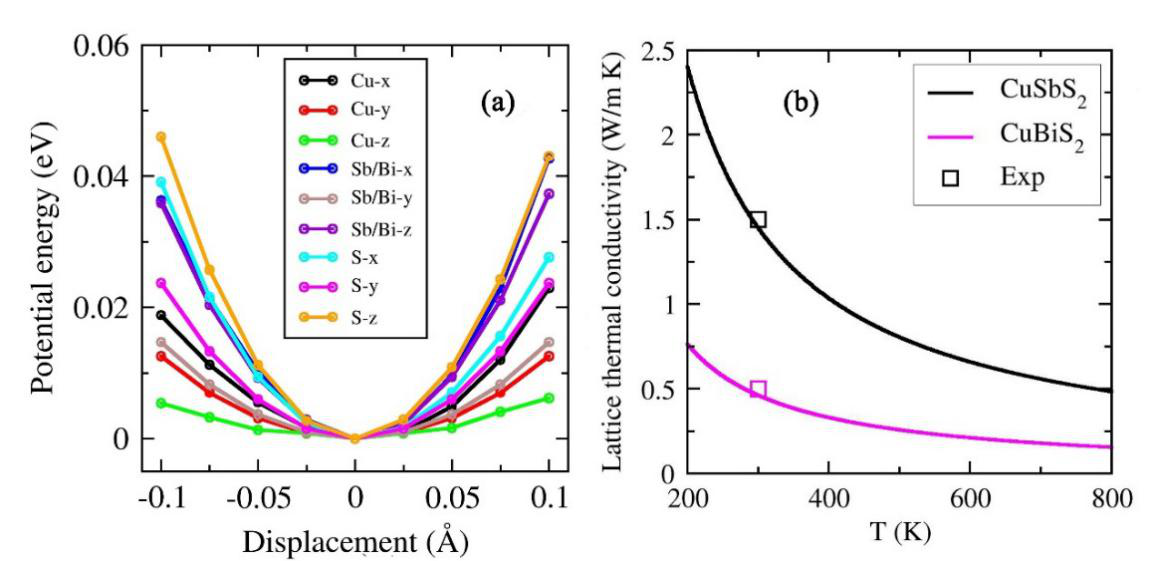
Recently, professor ZHANG Yongsheng, working in the research laboratory of computational materials science at the Institute of Solid State Physics, Hefei Institutes of Physical Science has made important progress in the research of low thermal conductivity.
The relevant results were published in Physical Review B entitled "Dual effects of lone-pair electrons and rattling atoms in CuBiS2on its ultralow thermal conductivity". And his paper was highlighted on the front page of the journal web site.
Thermoelectric material is one kind of functional materials which can directly convert heat into electricity. Searching the thermoelectric materials with intrinsically low lattice thermal conductivity is an approach to improve thermoelectric performance.
Many compounds from the family of natural minerals always exhibit intrinsically low lattice thermal conductivity. The lattice thermal conductivities of the two compounds are intrinsically low at room temperature: 1.5 W/mK and 0.5 W/mK for the two isostructural natural mineral compounds CuSbS2 and CuBiS2, respectively.
Therefore, it is the crucial issue to explore a better understanding of the determined physical factors for low lattice thermal conductivity in materials to look for and design new materials with the low lattice thermal conductivity and high thermoelectric performance.
By using density functional theory calculation, he found that lone-pair electrons would result in strong anharmonicity and hence reduce lattice thermal conductivity efficiently.
The stereochemically active lone-pair electrons at the Sb sites are major contributors to the large Grüneisen parameters in CuSbS2.
However, in CuBiS2, in addition to the lone-pair electrons at the Bi sites, the Cu ion rattling further raises the Grüneisen parameters. The larger Grüneisen parameters in CuBiS2 lead to an ultralow thermal conductivity compared with CuSbS2.
Moreover, the highest ZT value in CuBiS2 could reach 0.91 for the n-type doping at 700 K and 0.77 for the p-type doping at 780 K, which implies that good thermoelectric n- and p-type CuBiS2 can be achieved using the same pristine compound.
The ultralow lattice thermal conductivity and high figure of merit of CuBiS2 not only indicate the possibility of using sulfosalt systematics as efficient thermoelectric materials but also offer new insights into discovering and designing high-ZT thermoelectric materials with lone-pair electrons combined with the rattler atoms.
The research was supported by the financials of National Natural Science Foundation of China and the Major/Innovative Program of Development Foundation of Hefei Center for Physical Science and Technology Grant.
The calculations were performed in the ScGrid of Supercomputing Center and Computer Network Information Center of the Chinese Academy of Sciences.

Fig. 1. (a) The Electronic localization function (ELF) of CuBiS2 are projected onto the (101) plane. (b) Calculated Grüneisen dispersions for CuBiS2. (Image by FENG Zhenzhen)

Fig. 2. (a) The calculated potential energy curves for all the atoms as a function of displacement around the equilibrium positions along the x, y, and z directions for CuBiS2. (b) Calculated lattice thermal conductivity of CuMS2 (M = Sb, Bi). (Image by FENG Zhenzhen)

86-10-68597521 (day)
86-10-68597289 (night)

52 Sanlihe Rd., Xicheng District,
Beijing, China (100864)

